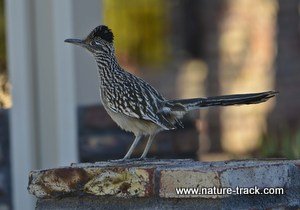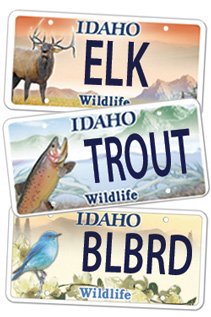Traveling to See Wildlife

This cooperative roadrunner allowed me to photograph it in Yuma, Arizona. I didn’t need to travel all the way to Yuma to see a roadrunner, but I would not have seen even one if I hadn’t left Idaho.
I wrote last week’s column in the shade of a porch in sunny Yuma, Arizona. Temperatures were in the mid seventies and golfers enjoyed the day on the Foothills course just over my father’s back wall. As I worked, a roadrunner, a large speedy ground bird, ran along top the wall. As it strutted back and forth I had time to call to my wife inside and grab a few photos before it jumped from the wall.
A few minutes later, dad’s neighbor came out and poured small mounds of seed on the top of each brick pillar. Within seconds, Gambel’s quail raced in from the golf course shrubbery. Several dozen jumped up and fed furiously on the bounty.
Collared doves joined in the fun at the impromptu feeders but there was another dove, much smaller, that I had never seen before. I photographed it and later determined it to be an Inca dove.
In five minutes I saw three species I could never see in Idaho. That reminded me why I like to travel. While Eastern Idaho is home to an amazing number of wildlife species, new species can be found relatively close by.
Where a species can or does exist is known as its range. Any competent field guide will have range maps that indicate where you are or are not likely to encounter that species. Changes in habitat type, elevation, latitude or longitude are likely to place you in habitats where new and different species are likely to occur.
For instance, if you live in Twin Falls, you must travel to Eastern Idaho to find a grizzly bear. However, just south of town you might encounter the state’s only known ring-tailed cats.
Probably the easiest way to find new species is to visit habitats different from where you live. For instance, marten, members of the weasel family, won’t be seen down on the Snake River Plain, but you will find them in abundance in Island Park.
Simply extending your travel circle will put you in many places where new animals roam. If you want to see a red fox, you don’t need to leave home. But if you want to find a swift fox, head for the deserts of Wyoming. If a kit fox is on your list, you don’t have a chance around Eastern Idaho. Try the Owyhee Desert, California, Nevada or Arizona.
There are also a large number of species and subspecies that are island isolationists. Their habitat is essentially an island. Sometimes this is literally where a large island is too far from shore to permit escape. However, there are many other kinds of islands such as lakes, mountain ranges surrounded by desert and even watersheds. Bear Lake’s Bonneville cisco is an example. This fish exists nowhere else in the world.
So, if you want to see new species, you don’t have to travel to Africa or the Galapagos, or even to Yuma. New species are often just a stone’s throw away.

Wildlife License Plates
Great news! as of 2024, there are three NEW designs for license plates. They still are bluebird, cutthroat trout and elk, but they are beautiful.
Idaho Wildlife license plates provide essential funding that benefits the great diversity of native plants and wildlife that are not hunted, fished or trapped—over 10,000 species or 98% of Idaho’s species diversity. Game species that share the same habitats (such as elk, deer, antelope, sage-grouse, salmon, trout) also benefit from these specialty plates.
No state tax dollars are provided for wildlife diversity, conservation education and recreation programs. Neither are any revenues from the sale of hunting or fishing licenses spent on nongame species. Instead, these species depend on direct donations, federal grants, fundraising initiatives—and the Idaho Wildlife license plates.
Both my vehicles have Bluebird Plates. I prefer the bluebird because the nongame program gets 70 percent of the money from bluebird plates, but only 60 percent of the money from elk and trout plates - 10 percent of the money from elk plates supports wildlife disease monitoring and testing programs (to benefit the livestock industry) and 10 percent from cutthroat plates supports non-motorized boat access.
Incidentally, in 2014, the Idaho Legislature denied the Department of Fish and Game the ability to add new plates or even to change the name of the elk and cutthroat plates (very specific) to wildlife and fish plates, a move that would have allowed for changing images occasionally and generating more revenue. It would seem that they believe that we Idahoans don't want a well funded wildlife program.
I think it is time we let the Legislature know that Idahoan support wildlife funding and that we would like to see these generic plates come to fruition.
Wildlife License Plates
Great news! as of 2024, there are three NEW designs for license plates. They still are bluebird, cutthroat trout and elk, but they are beautiful.
Idaho Wildlife license plates provide essential funding that benefits the great diversity of native plants and wildlife that are not hunted, fished or trapped—over 10,000 species or 98% of Idaho’s species diversity. Game species that share the same habitats (such as elk, deer, antelope, sage-grouse, salmon, trout) also benefit from these specialty plates.
No state tax dollars are provided for wildlife diversity, conservation education and recreation programs. Neither are any revenues from the sale of hunting or fishing licenses spent on nongame species. Instead, these species depend on direct donations, federal grants, fundraising initiatives—and the Idaho Wildlife license plates.
Both my vehicles have Bluebird Plates. I prefer the bluebird because the nongame program gets 70 percent of the money from bluebird plates, but only 60 percent of the money from elk and trout plates - 10 percent of the money from elk plates supports wildlife disease monitoring and testing programs (to benefit the livestock industry) and 10 percent from cutthroat plates supports non-motorized boat access.
Incidentally, in 2014, the Idaho Legislature denied the Department of Fish and Game the ability to add new plates or even to change the name of the elk and cutthroat plates (very specific) to wildlife and fish plates, a move that would have allowed for changing images occasionally and generating more revenue. It would seem that they believe that we Idahoans don't want a well funded wildlife program.
I think it is time we let the Legislature know that Idahoan support wildlife funding and that we would like to see these generic plates come to fruition.

"WOW. What a phenomenal piece you wrote. You are amazing." Jennifer Jackson
That is embarrassing, but actually a fairly typical response to my nature essays. Since The Best of Nature is created from the very best of 16 years of these nature essays published weekly in the Idaho Falls Post Register (online readership 70,000), it is a fine read. It covers a wide variety of topics including humorous glimpses of nature, philosophy, natural history, and conservation. Readers praise the style, breadth of subject matter and my ability to communicate complex and emotional topics in a relaxed and understandable manner.
Everyone can find something to love in this book. From teenagers to octogenarians, from the coffee shop to the school room, these nature essays are widely read and enjoyed.
Some of the essays here are my personal favorites, others seemed to strike a chord with readers. Most have an important message or lesson that will resonate with you. They are written with a goal to simultaneously entertain and educate about the wonderful workings of nature. Some will make you laugh out loud and others will bring a tear to the eye and warm your heart.
Readers Write:
"You hit a home run with your article on, Big Questions in Nature. It should be required reading for everyone who has lost touch with nature...great job!" Joe Chapman
"We enjoyed your column, Bloom Where Planted. Some of the best writing yet. The Post Register is fortunate to have your weekly columns." Lou Griffin.
To read more and to order a copy, click here or get the Kindle version
Copies are also available at:
Post Register
Island Park Builders Supply (upstairs)
Barnes and Noble in Idaho Falls
Harriman State Park, Island Park
Museum of Idaho
Valley Books, Jackson Wyoming
Avocet Corner Bookstore, Bear River National Wildlife Refuge, Brigham City, Utah
Craters of the Moon National Monument Bookstore, Arco, Idaho